Villano Bulldog
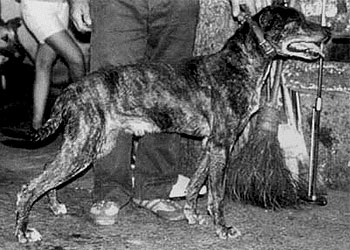 The rare Villano de las Encartaciones is believed by some to have origins in the 1100's, while others claim that the modern incarnation of the breed was created in the 19th century by crossing working Spanish Alanos with the Basque Herders and a variety of other Continental sheepdogs and hounds. Crosses between working dogs have been around forever and most Spanish breeds of this type do have roots in the same ancestral stock, but most fanciers of the great Villano de las Encartaciones strongly disagree with those who see the breed as a modern bandogge or just a regional variety of the Alano Espanol, a breed which owes its very survival to the employment of the Encartaciones dogs during the reconstruction. Also known as the Presa Espanol, a number of fanciers trace the Villano Bulldog to the Spanish Bulldog and the dogs brought back by sailors from Spanish colonies, such as the Perro Cimarron, Presa Canario and the Azores Cattledog, some of which can be traced back to the Villano dog themselves. Regardless of its ancestry, the Villano de las Encartaciones has traditionally been used in Western Spain to control rowdy cattle, herd sheep, hunt large game and guard farms. Although some dogs have been used for fighting in the past, this tenacious breed was never bred for that role. The Villano Bulldog is a valued working Molosser in the Bizkaia regions, where these powerful cattledogs are still celebrated for being able to grab and hold onto a bull's head and help the cattle dealers control their livestock.
The rare Villano de las Encartaciones is believed by some to have origins in the 1100's, while others claim that the modern incarnation of the breed was created in the 19th century by crossing working Spanish Alanos with the Basque Herders and a variety of other Continental sheepdogs and hounds. Crosses between working dogs have been around forever and most Spanish breeds of this type do have roots in the same ancestral stock, but most fanciers of the great Villano de las Encartaciones strongly disagree with those who see the breed as a modern bandogge or just a regional variety of the Alano Espanol, a breed which owes its very survival to the employment of the Encartaciones dogs during the reconstruction. Also known as the Presa Espanol, a number of fanciers trace the Villano Bulldog to the Spanish Bulldog and the dogs brought back by sailors from Spanish colonies, such as the Perro Cimarron, Presa Canario and the Azores Cattledog, some of which can be traced back to the Villano dog themselves. Regardless of its ancestry, the Villano de las Encartaciones has traditionally been used in Western Spain to control rowdy cattle, herd sheep, hunt large game and guard farms. Although some dogs have been used for fighting in the past, this tenacious breed was never bred for that role. The Villano Bulldog is a valued working Molosser in the Bizkaia regions, where these powerful cattledogs are still celebrated for being able to grab and hold onto a bull's head and help the cattle dealers control their livestock.
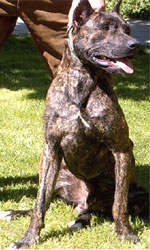
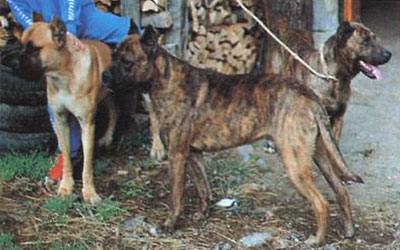 Relatively unknown even in Spain, the Villano de las Encartaciones almost became extinct during the World Wars, but in the 1960's revival efforts were successful and the breed survived. Certain fanciers claim that these modern specimens are very different than the original Villano Bulldogs, due to a number of working scenthounds and sighthounds, as well as the Perro de Toro having been used as outcrosses during the salvation years, while other enthusiasts point out that the breed hasn't been re-constructed, but was simply revived using traditional breeding practices, which have always relied on periodical outcrossing, especially in the hunting community. Instead of crossing a few foreign breeds together and calling the product by the name of Villano Bulldog, the post-WW2 Presa Espanol breeders simply maintained their breed the same way as their ancestors, using the leftover Villano stock as a foundation, while introducing a few local hunting dogs into the gene pool and then selecting for correct type and working ability. The present-day Villano de las Encartaciones is somewhat taller and lighter than its ancestors, but it is also a more trainable and calmer breed. Still unrecognized and rare, but slowly gaining popularity in its homeland, the legendary Presa Espanol was finally honoured in 1997 by the official establishment of the National Villano de las Encartaciones Club.
Relatively unknown even in Spain, the Villano de las Encartaciones almost became extinct during the World Wars, but in the 1960's revival efforts were successful and the breed survived. Certain fanciers claim that these modern specimens are very different than the original Villano Bulldogs, due to a number of working scenthounds and sighthounds, as well as the Perro de Toro having been used as outcrosses during the salvation years, while other enthusiasts point out that the breed hasn't been re-constructed, but was simply revived using traditional breeding practices, which have always relied on periodical outcrossing, especially in the hunting community. Instead of crossing a few foreign breeds together and calling the product by the name of Villano Bulldog, the post-WW2 Presa Espanol breeders simply maintained their breed the same way as their ancestors, using the leftover Villano stock as a foundation, while introducing a few local hunting dogs into the gene pool and then selecting for correct type and working ability. The present-day Villano de las Encartaciones is somewhat taller and lighter than its ancestors, but it is also a more trainable and calmer breed. Still unrecognized and rare, but slowly gaining popularity in its homeland, the legendary Presa Espanol was finally honoured in 1997 by the official establishment of the National Villano de las Encartaciones Club.
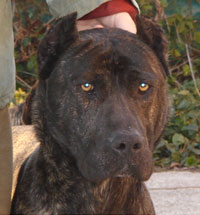
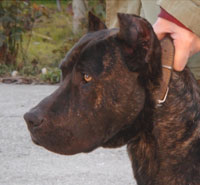 Suspicious of strangers and very intuitive, these tough Spanish Molossers make excellent property watchdogs. The Presa Espanol is friendly and playful with children and its owner, but needs socialization in order to keep its territorial and protective nature under control. Males are known to be fairly dog-aggressive, although the breed as a whole has a very strong prey drive and may chase smaller animals when given a chance. Being a true working breed, it is much happier when employed to control cattle on farms or used for hunting wild boars and other game, but when raised properly and provided with enough excercise, this rugged and energetic breed can make a good family companion. Muscular and well-boned, the Villano de las Encartaciones is a healthy and agile Moloss. The ears are traditionally cropped, while the tail is left unaltered.
Suspicious of strangers and very intuitive, these tough Spanish Molossers make excellent property watchdogs. The Presa Espanol is friendly and playful with children and its owner, but needs socialization in order to keep its territorial and protective nature under control. Males are known to be fairly dog-aggressive, although the breed as a whole has a very strong prey drive and may chase smaller animals when given a chance. Being a true working breed, it is much happier when employed to control cattle on farms or used for hunting wild boars and other game, but when raised properly and provided with enough excercise, this rugged and energetic breed can make a good family companion. Muscular and well-boned, the Villano de las Encartaciones is a healthy and agile Moloss. The ears are traditionally cropped, while the tail is left unaltered.
The coat is short and flat, usually dark brindle in colour, but lighter dogs can be found, as well as the specimens with white markings. Average height is around 23 inches, although taller dogs exist.
